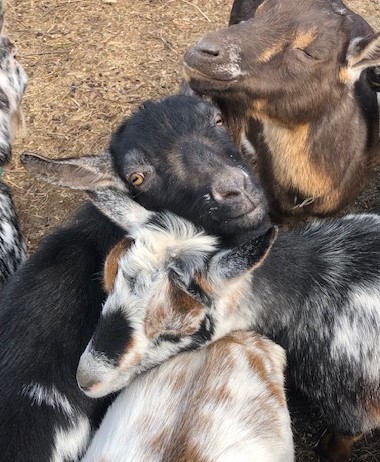Used to be, “getting your goat” was not a good thing. The phrase is said to derive from a practice in horse racing, whereby a goat was placed in a stall with a thoroughbred before the race. Among strange surroundings, circumstances and unfamiliar people, the presence of a goat is said to calm a horse’s nerves the night before the big event.
But a member of a rival camp would sometimes in secret abscond with said comfort animal - get your goat - seeking to agitate an opponent’s horse and thereby gain advantage in the race.
Yet getting your goat is coming to mean quite the opposite these days, as the endearing animals are increasingly being recruited to relieve the stresses and symptoms of life for their two-legged friends.
“There’s research that petting friendly animals improves moods,” said Anishe Antoniadis. She owns and operates Positively Goats, an organization that partners with the animals to improve the lives of people.
On the second floor of a large barn on the farm where she works, Antoniadis has set up a small classroom. There, participants gather in small groups to learn about goats - everything from behavior to anatomy to diet. Below are a series of stables, home to a group of horses. Goat and horse alike are allowed to roam in open areas outside the stables and pens, to forage for food.
Horses are among a group of animals considered grazers, creatures that nibble at the grass beneath their feet. Goats, by comparison, are browsers. As the name suggests, theirs is a more varied menu of items to choose from.
Goats are athletic jumpers and balancers, sometimes climbing trees to access a tasty meal of pine needles. Their four-chambered stomachs allow for a more varied diet, which also includes leaves, hay, grass and flowers.
But being a browser is not synonymous with having slipshod dietary standards. Contrary to popular belief, goats are very finicky eaters. Although curious, they stick to favored and familiar food items, and will most often refuse edibles they deem dirty or that have been on the ground.
Bipedal participants of the program are put at ease that human fingers are in no danger from nibbling goats, as they lack a set of upper, frontal teeth. A good-natured gumming is the toughest treatment one can expect.
Up close, the eye of a goat is something to behold. Their longish, rectangular pupils are horizontal, which gives the eerie, cartoonish impression they’ve been hypnotized. Yet the orientation and shape of the pupil allows goats a very generous field of view - up to twice that of a human. This enhanced vision helps protect goats from predators seeking to sneak up from behind.
In their pen, each of Antoniadis’ eight goats vie for attention from visitors, who can brush or scratch the coarse hair (not fur) that manifests in some strikingly beautiful patters and tones. At first glance, Gertie the goat seems to be wearing a set of four brown knee-high boots, in contrast with a coat of hair like some abstract painting. A blizzard of off-white streaks is set against her black and brown coat, like inspired brush strokes upon a dark canvas. Gertie’s reputation among the herd is that of the extrovert, the goat sometimes leaping like a Labrador onto unguarded laps for some attention and grooming.
From head to tail, a strip of hair will stand on end when a goat’s gumption is up. Like plumes of mohawk horsehair atop ancient battle helmets, the phenomenon is meant to impart a sense of larger stature to opponents. The goats engage as friendly gladiators in their fenced-in arena, rearing on hind legs to descend with a decisive head butt against a goat encroaching on norms or personal space.
Antoniadis has a degree in counseling, and in that capacity at a residential treatment center saw a need for a more holistic approach in caring for and counseling people with special needs. She had also been volunteering at a nursing home, and one day brought along a dog. Seeing the positive response to her four-legged co-counselor, Antoniadis decided to earn a certificate in animal-assisted therapy.
She soon connected with a woman who raises goats as pets and for therapy, and the rest is history. Antoniadis fell in love with her new four-legged friends. “I noticed that I felt great after spending time with them,” she said. “I decided to follow my heart. I wanted to offer that to other people.”
That includes people of all ages and with special needs. She runs the program by herself at Natick’s South Street Farm, a property owned by her mother. Antoniadis’ husband is an artist, and operates a studio on the bucolic grounds.
Last summer, Positively Goats held a summer camp for teens with mental health challenges. The program included homework assignments, and a week of extended, daily visits with the goats. “I have noticed that people tend to talk about things and open up more,” around the goats, said Antoniadis.
The increasingly popular phenomenon of “goat yoga” has also been part of Antoniadis’ offerings. The calming presence of the goats is said to complement the move toward mindfulness and meditative practice. A search reveals participants in a variety of poses, with baby goats (kids) calmly perched atop the backs of practitioners. Antoniadis’ family of goats has grown too large for this novelty, though the herd may be expecting some new additions soon, and with them, more yoga.

Issue Date:
April, 2020
Article Body:
